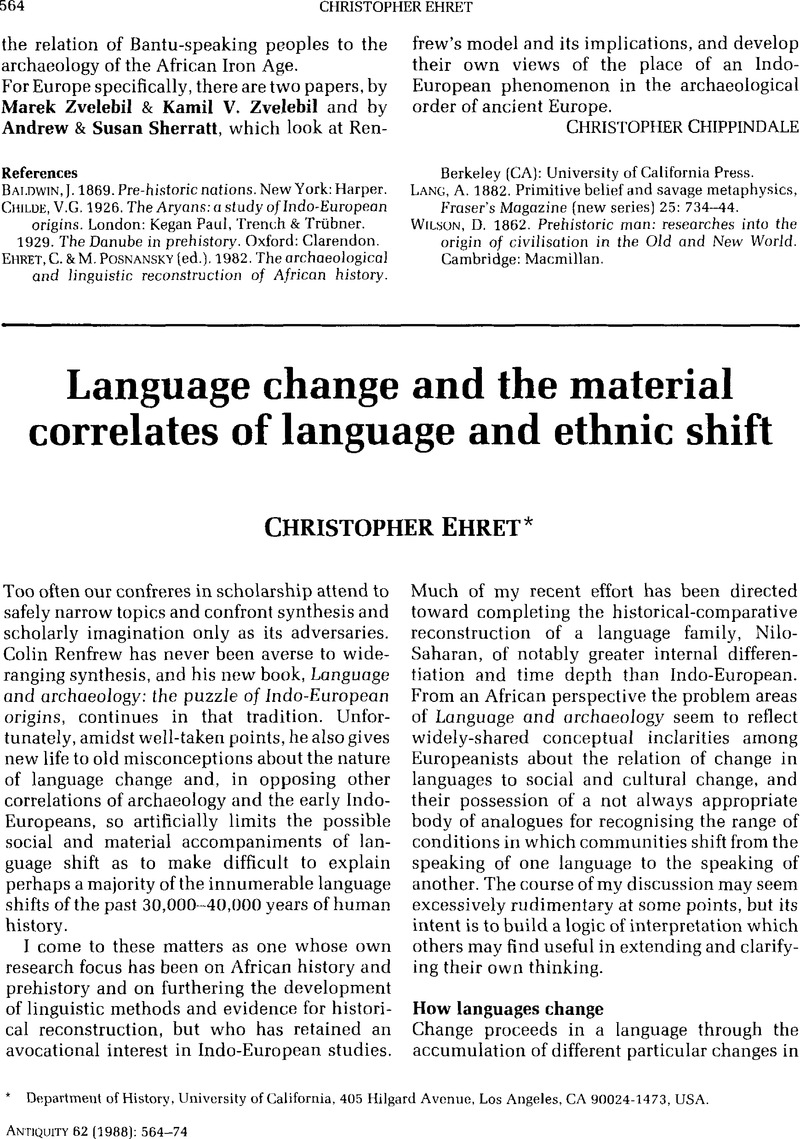Crossref Citations
This article has been cited by the following publications. This list is generated based on data provided by Crossref.
Renfrew, Colin
1989.
MODELS OF CHANGE IN LANGUAGE AND ARCHAEOLOGY.
Transactions of the Philological Society,
Vol. 87,
Issue. 2,
p.
103.
McConvel, Patrick
1990.
The Linguistic Prehistory Of Australia: Opportunities For Dialogue With Archaeology.
Australian Archaeology,
Vol. 31,
Issue. 1,
p.
3.
Barber, E.J.W.
1991.
Review of L. Markey & Greppin (1990): When Worlds Collide: The Indo-Europeans and Pre-Indo-Europeans.
Diachronica,
Vol. 8,
Issue. 1,
p.
93.
Renfrew, Colin
1991.
Before Babel: Speculations on the Origins of Linguistic Diversity.
Cambridge Archaeological Journal,
Vol. 1,
Issue. 1,
p.
3.
Robb, John
1991.
Random causes with directed effects: the Indo-European language spread and the stochastic loss of lineages.
Antiquity,
Vol. 65,
Issue. 247,
p.
287.
Hines, John
1991.
Reviews.
Norwegian Archaeological Review,
Vol. 24,
Issue. 1,
p.
49.
Barbujani, Guido
Pilastro, Andrea
De Domenico, Silvia
and
Renfrew, Colin
1994.
Genetic variation in North Africa and Eurasia: Neolithic demic diffusion vs. paleolithic colonisation.
American Journal of Physical Anthropology,
Vol. 95,
Issue. 2,
p.
137.
Zvelebil, Marek
1995.
At the Interface of Archaeology, Linguistics and Genetics: Indoeuropean Dispersals and the Agricultural Transition in Europe.
Journal of European Archaeology,
Vol. 3,
Issue. 1,
p.
33.
Wylie, Alison
1996.
Unification and Convergence in Archaeological Explanation: The Agricultural “Wave‐of‐Advance” and the Origins of Indo‐European Languages.
The Southern Journal of Philosophy,
Vol. 34,
Issue. S1,
p.
1.
Bellwood, Peter
1996.
Phylogenyvsreticulation in prehistory.
Antiquity,
Vol. 70,
Issue. 270,
p.
881.
Sims-Williams, Patrick
1998.
Genetics, linguistics, and prehistory: thinking big and thinking straight.
Antiquity,
Vol. 72,
Issue. 277,
p.
505.
2001.
The Quest for the Origins of Vedic Culture.
p.
iv.
Bryant, Edwin
2001.
The Quest for the Origins of Vedic Culture.
p.
76.
Bryant, Edwin
2001.
The Quest for the Origins of Vedic Culture.
p.
3.
2001.
The Quest for the Origins of Vedic Culture.
p.
v.
Keita, S.O.Y.
2005.
History in the interpretation of the pattern of p49a,fTaqI RFLP Y-chromosome variation in Egypt: A consideration of multiple lines of evidence.
American Journal of Human Biology,
Vol. 17,
Issue. 5,
p.
559.
Keita, S. O. Y.
2005.
Explanation of the Pattern of P49a,f TaqI RFLP Y-Chromosome Variation in Egypt.
African Archaeological Review,
Vol. 22,
Issue. 2,
p.
61.
Keita, S.O.Y.
and
Boyce, A.J.
2005.
Genetics, Egypt, and History: Interpreting Geographical Patterns of Y Chromosome Variation.
History in Africa,
Vol. 32,
Issue. ,
p.
221.
Blench, Roger
2006.
A Companion to Archaeology.
p.
52.
Fuller, Dorian Q
2007.
The Evolution and History of Human Populations in South Asia.
p.
393.


